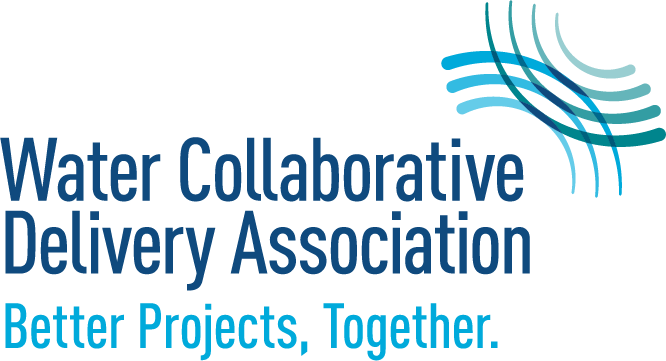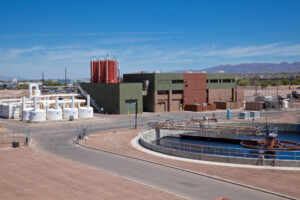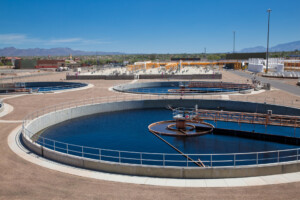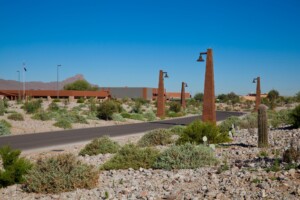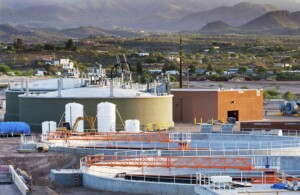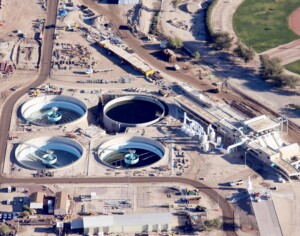Challenge
Set amidst the Sonoran Desert, water in Pima County is a vital yet sparse resource. The Lower Santa Cruz River supports desert life, replenishes the region’s drinking water supplies, and is a playground to residents and visitors alike. Protecting this valuable resource is a key priority for the Pima County Regional Wastewater Reclamation Department (RWRD). Concerned that treated wastewater discharged into the Santa Cruz River could affect local groundwater supplies, Arizona regulators required that the WRF reduce the nitrogen in its effluent by January 2015. The fast-tracked project features the major upgrade and expansion of a 1970s vintage wastewater treatment plant, expanding the plant capacity from 37.5 to 50 million gallons per day (mgd), converting the process to nutrient removal, increasing automation for enhanced process control, incorporating extensive odor control as a good neighbor, providing regional biosolids processing for beneficial reuse, and incorporating architecture and landscaping to mirror the enduring beauty of the Sonoran Desert.
The Tres Rios WRF Capacity and Effluent Quality Upgrade Project is the largest construction project completed in Pima County’s history. It satisfies the Clean Water Act’s stringent environmental regulatory requirements, meets RWRD’s long-term service needs, and augments precious water supplies for this growing desert community.
Approach
To meet this ambitious schedule, in July 2008 RWRD awarded a construction management at-risk (CMAR) contract for its most difficult upgrade project. In close partnership with RWRD, the integrated CMAR team consisting of CH2M (now Jacobs) as the design engineer, Jacobs as the construction manager, and MWH Constructors as the CMAR completed this complex project on budget and three months ahead of regulatory deadlines while maintaining vital wastewater services throughout the construction period. This integrated team tackled project challenges together through collaboration across the entire project lifecycle, creating a unique teaming environment that overcame the toughest challenges with minimal scope changes and no violations or delays.
Results
Planning for and executing construction was especially challenging. Because RWRD’s wastewater system functions as a single integrated unit, all plant permitting, design, and construction had to be carefully coordinated with ongoing projects. Most importantly, as an end-of-the-line facility, it was vital the WRF remain operational throughout construction to meet regulatory requirements. The integrated CMAR team planned for the project’s complex challenges in the earliest stages of design, realizing the following outcomes:
- Unearthed a 3,000-year-old agricultural irrigation system, one of North America’s earliest and most sophisticated, and preserved this national treasure while protecting the project’s tight construction schedule. Coordination with archeologists and researchers led to the recovery of artifacts that have been
donated to the Arizona State Museum. MWH used a phased construction approach to install a gravity belt thickener and two digesters while the archaeological excavations were completed, avoiding at least six months in potential delays. - Early value engineering efforts yielded $62 million in cost savings, of which $40 million was accepted by RWRD, keeping construction costs below the original master plan budget.
- Engaged local subcontractors to complete critical portions of the project, exceeding local and SBE goals through outreach efforts directed at small businesses.
- Developed and completed over 450 maintenance of plant operations, 250 electrical switchover ties, and three complete plant shutdowns through close collaboration among Jacobs, MWH, and plant operations & maintenance staff, maintaining 24/7 community operations at all times without incident.
- The project team worked over a million man-hours with no lost time injuries on what RWRD considers its most difficult project.
- Produced a high-quality effluent to improve the health of the unique Santa Cruz River ecosystem, increasing the diversity of species along the river while preserving the desert’s wetlands.
- Employed sustainability measures to reduce overall energy use.
Awards
- 2015 AZ Water Association, Wastewater Treatment Project of the Year
- 2014 Public Works Project of the Year, American Public Works Association (Arizona Chapter)
- 2013 Metropolitan Pima Alliance, Common Ground Award for Partnering
“MWH was a great partner constructing our facility, which uses state-of- the-art technology, a lot of automation, and a lot of process control, which will further enhance efficiencies and allow us to streamline our business on top of adding to the sustainability of our community. I trust the Jacobs design team because they are a proven partner. They’ve met every budget they’ve committed to and delivered quality documents. They have been the engine that kept the project moving.”
—Jackson Jenkins, Director, Pima County Regional Wastewater Reclamation Department
